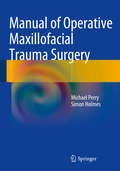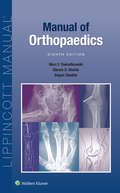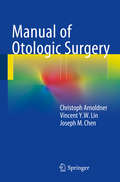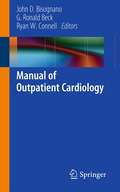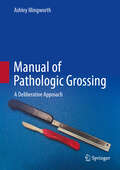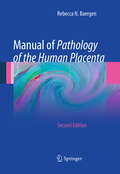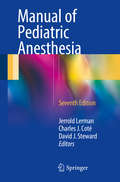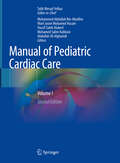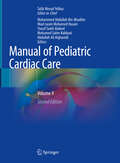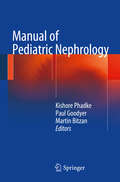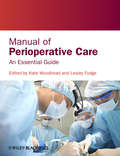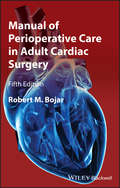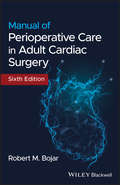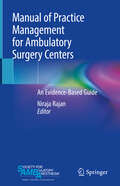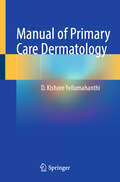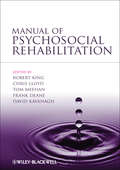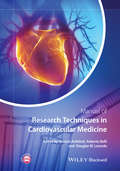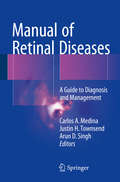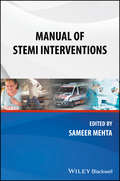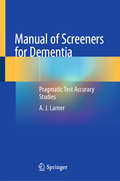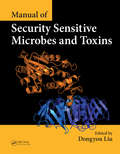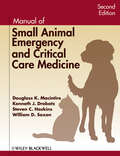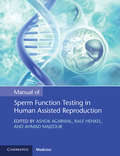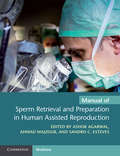- Table View
- List View
Manual of Operative Maxillofacial Trauma Surgery
by Michael Perry Simon HolmesThis manual is a condensed and didactic "how to" book, demonstrating surgical procedures in a step by step manner. It is fully comprehensive and highly illustrated (in colour, using mostly operative photographs), restricted solely to the surgical management of maxillofacial trauma, but includes most of the surfical approaches and methods of repair for all maxillofacial injuries. By including all surgical procedures (in trauma) this manual will make a useful and portable accompaniment to the Atlas of Operative Maxillofacial Trauma Surgery. It will be a good resource for all trainees, not only in maxillofacial surgery, but also in other related specialties.
Manual of Orthopaedics (Lippincott Manual Series)
by Marc F. SwiontkowskiNow in vibrant full color, Manual of Orthopaedics, Eighth Edition, provides the must-know information you need to diagnose and treat musculoskeletal injuries and diseases with confidence. This quick-reference manual has been completely updated and revised to include content particularly valuable for orthopaedic physician assistants, while retaining key information for orthopaedic residents and nurse practitioners, primary care physicians, and orthopaedic providers in all practice environments.
Manual of Otologic Surgery
by Christoph Arnoldner Vincent Y. W. Lin Joseph M. ChenThis book takes the reader step-by-step through routine temporal bone surgeries while maximizing the use of the cadaver tissue. In an effort to improve visual realism, the book provides high-resolution photographs and anatomically accurate illustrations to allow the reader to better appreciate the three-dimensional relationship of the internal constructs of the temporal bone. Special emphasis is placed on describing the latest techniques for cochlear implantation and active middle ear implants. The book is further enhanced by additional links to edited videos of surgical cases and will therefore serve as a valuable reference guide to otologic surgeons of all experience levels.
Manual of Outpatient Cardiology
by Ryan W. Connell G. Ronald Beck John D. BisognanoPractical, didactic format designed to deliver point-of-care information to practitioners of cardiology. Highly illustrated with schematics and useful clinical figures, this will be an essential reference to all outpatient cardiology procedures.
Manual of Pathologic Grossing: A Deliberative Approach
by Ashley IllingworthThis textbook is a step-by-step, at the bench, real-world approach to grossing a wide variety of surgical cases. Each figure is produced directly from the bench during the grossing process with the associated dictation. These specimens contain the imperfections of real-life cases with ample illustrations drawn by renown medical illustrationist Kyle Cunningham. This book is not a bullet-point list of what to do but rather a step-by-step, illustrated approach to grossing each specimen. This manual can be utilized at the bench with any specimen at any time. Key features include step-by-step photographic documentation of optimal methods for handling gross specimens commonly seen in the pathology laboratory, medical illustrations that highlight key anatomic features, and tips and tricks to produce optimal diagnostic sections for pathologic diagnosis. Each chapter also includes multiple choice questions to help apply the knowledge and skills learned in the readings. This text is not just a reference manual. It is a deliberative teaching manual meant to be taken into the lab and used at the bench providing consultative support. The text is specifically focused on pathology residents learning grossing skills when no one is around to answer questions. Currently, there are four main surgical grossing texts on the market. Those texts contain drawings and characterizations of the perfect organ and a list of sections needed for each specimen. These books do not focus on the methodology for taking the most appropriate sections with a focus on handling imperfect specimens. Manual of Pathologic Grossing is the only text that includes photographs of each step in the grossing process. The photos are accompanied by a step-by-step text of demonstrating how and why each section was taken.
Manual of Pathology of the Human Placenta
by Rebecca N BaergenManual of Pathology of the Human Placenta, Second Edition is a concise, practical manual of placental pathology. While references are made to the more encyclopedic Pathology of the Human Placenta, this Manual is designed as a user-friendly, easy-to-read bench manual that can be used in the grossing room as well as at the microscope. Features of the text include:- A section on the approach to the placental specimen, providing suggestions on what to do, as well as when and how to do it.- Discussion of detailed development and normal histology of all parts of the placenta for those wanting to learn about specific areas of the placenta.- Discussion of placental lesions, disease processes related to the placenta, neoplasms, and trophoblastic lesions. An overview of the legal implications of placental examination and future direction. "Suggestions for Examination and Report" includes key points in gross examination, sectioning, and diagnosis. Suggestions for comments in the surgical pathology report guide the reader in problematic situations or when the diagnosis or diagnostic implications are unclear.An abundance of tables summarize pertinent information and provide easy access to the differential diagnoses of various lesions. Manual of Pathology of the Human Placenta is a must-have reference for every pathologist, resident and pathology assistant.
Manual of Pediatric Anesthesia
by Jerrold Lerman Charles J. Coté David J. StewardAuthored by three world experts, this is a clinically focused book on pediatric anesthesia. "The Manual", as it is known, has long dominated the market for a succinct and practical resource on administering anesthesia to children and is used by residents, general anesthesiologists, nurse anesthetists, and pediatric anesthesiologists. This new edition retains the basic structure of the book and is updated throughout. Text-heavy in the current edition, the Seventh Edition features the addition of figures to chapters where they are especially helpful (eg, the chapter on cardiovascular surgery and cardiac procedures) and makes greater use of headings to break up the text and guide reading. From reviews of the Sixth Edition:"This is an extremely well written book that I would recommend highly to anyone involved in anaesthetizing children. It is comprehensive enough to provide an excellent reference for trainees and general anaesthetists who occasionally deal with paediatric cases, while at the same time giving valuable supplemental information for paediatric anaesthetists encountering an unusual procedure or condition. In short, this is a book that would make a welcome addition to any anaesthetist's mobile library. " --Anaesthesia
Manual of Pediatric Cardiac Care: Volume I
by Talât Mesud Yelbuz Yousif Saleh Alakeel Mohamed Salim Kabbani Abdullah Ali Alghamdi Mohammed Abdullah Bin-Moallim Wael Jasim Mohamed HusainThis two-volume manual covers the most relevant protocols in pediatric cardiac care to serve as a practical guide that matches and reflects the high level of accumulated knowledge and expertise in this clinical field. It includes 179 chapters and offers comprehensive, precise, and up-to-date practical tips with specific care protocols to provide the most efficient strategies for high-quality care in patients with congenital heart disease (CHD). This book simplifies learning with many tables, flowcharts, graphs, and algorithms for easy access and fast action. Volume I covers many key sections, such as prenatal morphogenesis and physiology of the human heart, fetal cardiology, neonates and congenital heart disease, cardiac imaging, pediatric cardiac catheterization, pediatric cardiac electrophysiology, critical events and emergency procedures in pediatric cardiac care, management of specific cardiac conditions, general pediatric and subspecialty issues related to children with CHD, follow-up standards in pediatric outpatient cardiology clinic, prophylaxis in children with CHD, quality aspects, professional conduct and training in pediatric cardiac care. This manual is a must-have resource for pediatricians, neonatologists, clinical pharmacy specialists, pediatric intensive care physicians, pediatric cardiologists, pediatric cardiac intensive care physicians, pediatric cardiac surgeons, and/or surgeons interested in pediatric cardiac surgery.
Manual of Pediatric Cardiac Care: Volume II
by Talât Mesud YelbuzThis two-volume manual covers the most relevant protocols in pediatric cardiac care to serve as a practical guide that matches and reflects the high level of accumulated knowledge and expertise in this clinical field. It includes 179 chapters and offers comprehensive, precise, and up-to-date practical tips with specific care protocols to provide the most efficient strategies for high-quality care in patients with congenital heart disease (CHD). This book simplifies learning with many tables, flowcharts, graphs, and algorithms for easy access and fast action. Volume II covers many vital sections, such as ethical considerations in pediatric cardiac patients, pediatric cardiac surgery, pediatric cardiac intensive care unit (PCICU) guidelines, clinical pharmacy guidelines, adults with congenital heart disease, appendix (with normal values/reference tables/graphs/scores and various calculated indexes used and needed for proper pediatric cardiac care).This manual is a must-have resource for pediatricians, neonatologists, clinical pharmacy specialists, pediatric intensive care physicians, pediatric cardiologists, pediatric cardiac intensive care physicians, pediatric cardiac surgeons, and/or surgeons interested in pediatric cardiac surgery.
Manual of Pediatric Nephrology
by Kishore D. Phadke Paul Goodyer Martin BitzanThis manual will meet the everyday needs of the wide range of medical professionals who play a role in the treatment of children referred to hospital because of renal disease. It is an easy-to-use, portable guide that will assist pediatricians, residents, and trainees in making prompt first-level management decisions. It will also prove invaluable for the adult nephrologists who care for children in many developing countries, and will serve as a teaching guide for experts when training non-subspecialists. Individual sections are devoted to the evaluation of renal disease; fluid, electrolyte, and acid-base disorders; glomerular diseases; tubular disorders; congenital, inherited, and urological disorders; consequences of renal disease; and miscellaneous topics. The text is in a bulleted format with tables and algorithms wherever possible, making it straightforward and easy to read. An appendix includes further important information such as normal values, drug dosages, and drug nephrotoxicity.
Manual of Perioperative Care
by Lesley Fudge Kate WoodheadManual of Perioperative Care is a comprehensive manual of principles of care designed to support the clinical practice of perioperative practitioners, whether they are nurses or operating department practitioners. This book meets the needs of those studying perioperative practice as well as those who would like an up-to-date comprehensive reference on their bookshelf. It covers the fundamentals of perioperative practice, placing them within the wider context of modern surgical care.With a practical, accessible focus, aided by full colour illustrations, this book follows the journey that the patient makes through their surgical care, with sections on:The foundation for safe and effective perioperative careInfection prevention and controlPatient safety and managing risksDifferent patient care groupsApproaches to surgeryThis book is essential reading for all students on perioperative courses, as well as newly qualified perioperative nurses and operating department practitioners.
Manual of Perioperative Care in Adult Cardiac Surgery
by Robert M. BojarThe fifth edition of Bojar's Manual of Perioperative Care in Adult Cardiac Surgery remains the gold standard for management of adult patients undergoing cardiac surgery. The easily referenced outline format allows health practitioners of all levels to understand and apply basic concepts to patient care--perfect for cardiothoracic and general surgery residents, physician assistants, nurse practitioners, cardiologists, medical students, and critical care nurses involved in the care of both routine and complex cardiac surgery patients. This comprehensive guide features: Detailed presentation addressing all aspects of perioperative care for adult cardiac surgery patients Outline format allowing quick access to information Chronological approach to patient care starting with diagnostic tests then covering preoperative, intraoperative, and postoperative care issues Additional chapters discuss bleeding, the respiratory, cardiac, and renal subsystems as well as aspects of care specific to recovery on the postoperative floor Updated references, information on new drug indications and new evidence to support various treatment/management options. Practical and accessible, this new edition of Manual of Perioperative Care in Adult Cardiac Surgery is the essential reference guide to cardiac surgical patient care.
Manual of Perioperative Care in Adult Cardiac Surgery
by Robert M. BojarNow in its sixth edition, Robert M. Bojar's Manual of Perioperative Care in Adult Cardiac Surgery remains the go-to practical guide for all of those involved in the care of the cardiac surgery patient. Written in outline format, it provides a comprehensive, detailed, and clearly explained review of cardiac surgical disease and perioperative management that is of value to practicing cardiac surgeons as well as to cardiologists, residents, fellows, advanced practice providers, critical care and floor nurses, perfusionists, and medical students. Extensively rewritten with updated references to incorporate the latest concepts, guidelines, protocols, and medications used in cardiac surgical practice, this classic text retains the pragmatic features that have made it the gold standard reference that clinicians have used worldwide for the past 30 years. Highlights include: Full coverage of cardiac surgical diseases, including pathophysiology, indications for surgery per guidelines, and figures of operative procedures and diagnostic techniques, with a panoply of examples Chronologic evaluation of patients from preoperative assessment to intraoperative considerations to postoperative care for each procedure Extensive chapters discussing organ system management in the ICU, followed by a discussion of later postoperative management and problems Incorporation of newer techniques (TAVR, Mitraclip, etc.) within the chronologic format Easy access to information using an outline format, markers on the free edges to identify chapters, synopsis pages at the beginning of each chapter, and a comprehensive index to provide easy referencing within the text Updated references throughout that are available from on-line resources 21 appendices summarizing order sheets, protocols, commonly used drug doses, body mass index, and other important information Praise for the fifth edition: "Surgeons are frequently asked to recommend a text that can be used to guide the care of their patients. This comprehensive text is the standard by which any other text should be judged." —Critical Care Medicine "It remains a classic and a must have for anyone involved in cardiac surgery." —Perfusion.com
Manual of Practice Management for Ambulatory Surgery Centers: An Evidence-Based Guide
by Niraja RajanThis key resource provides insight and guidance to managing ambulatory surgery centers (ACSs) from a broad spectrum of expertise. Intended for a wide audience of healthcare professionals, this book covers topics such as regulatory issues, outpatient pediatric anesthesia, inventory management, personnel training, the culture of safety, and sedation standards. The format found in each chapter is designed intentionally to function as an educational manual. Many chapters are supplemented by high quality figures and tables to aid in visual learning.This text brings together authors from diverse professions including lawyers, administrators, surgeons, anesthesiologists and architects – all of whom have contributed their expertise to address the multitude of subjects that pertain to ASCs. Manual of Practice Management for Ambulatory Surgery Centers: An Evidence-Based Guide is a concise and evidence-based guide to successfully operating the modern health care facilities that have transformed the outpatient experience for millions of people.
Manual of Primary Care Dermatology
by D. Kishore YellumahanthiThis manual describes the issues of diagnosing and managing skin diseases relevant to primary care, where the vast majority of dermatology patients are initially investigated. In most circumstances, primary care physicians need to assess and diagnose skin conditions without the aid of any laboratory or other diagnostic tests. Given that dermatological training for primary care providers is limited, this can make it challenging to diagnose skin diseases accurately, more so for those in the early stages of their career. The Manual of Primary Care Dermatology is written by a dermatologically trained practicing primary care physician to address the issues in managing skin diseases in primary care medicine. It provides readers with practical guidance on the differential diagnosis of skin diseases. The anatomical approach presented makes it easy for the reader to manage their patients' skin condition. With chapters dedicated to lesions of the scalp, face or upper extremity, it represents a quick reference book even for a busy practitioner. It is therefore essential reading for all primary care physicians and dermatologists looking for a compact reference to the differential diagnosis of all skin diseases.
Manual of Psychosocial Rehabilitation, 1st Edition
by Tom Meehan David Kavanagh Frank Deane Chris Lloyd Robert Kingprovides manuals and programs for interventions effectively provided as group activities. Section 4 explains how to design a full programme that integrates therapeutic interventions with group programmes as well as services provided by other agencies. The final section looks at peer support and self help, providing manuals and resources that support programmes and interventions not requiring professional or practitioner direction.
Manual of Research Techniques in Cardiovascular Medicine
by Roberto Bolli Hossein Ardehali Douglas W. LosordoWhile some research methods or techniques are applicable in several areas of medicine, research in cardiovascular diseases requires knowledge of an increasing array of procedures, techniques and measurements that are highly specialized and unique to this area of investigation. Edited by senior clinical investigators who are recognized leaders in cardiovascular medicine worldwide, this book provides readers with a comprehensive, practical "how-to-do-it" review of best-practice techniques for cardiovascular research.
Manual of Retinal Diseases
by Arun D. Singh Carlos A. Medina Justin H. TownsendThis book is a comprehensive source of authoritative information on the clinical features,diagnosis, differential diagnosis, and management of medical and surgical retinal diseases. The Manual has 122 chapters, organized in 18 sections covering medical and surgical aspects of retinal diseases such as trauma, AMD, Uveitis, infections, endophthalmitis, pediatric diseases, dystrophies, and tumors. Easy-to-read chapters convey the fundamental concepts with the aid of clinical photographs, imaging studies (including fluorescein and indocyanine angiograms, ultrasonograms, CT scans, and MRI scans) and tables. The manual is of value to a wide range of practitioners and trainees, including students,residents, fellows and ophthalmologists who treat retinal diseases.
Manual of STEMI Interventions
by Sameer MehtaBenefit from this concise yet comprehensive manual, designed to improve the practice and process of STEMI interventions Understand the varied pharmacological options available in managing STEMI patients, including newer anti-coagulants Improve your STEMI procedure technique through expert guidance, including stent choice, and other techniques such as trans radial procedures Provides an overview of STEMI networks internationally and how to set up a STEMI program Reviews future perspectives for STEMI and the role of telemedicine for STEMI procedures
Manual of Screeners for Dementia: Pragmatic Test Accuracy Studies
by A. J. LarnerThis book draws on the author’s experience in conducting pragmatic test accuracy studies on screening instruments for dementia/mild cognitive impairment. To facilitate comprehension and assimilation, all data is presented in an easily accessible, succinct and user-friendly way by means of a structured tabular format that allows tests to be easily compared. The pragmatic design of studies ensures high external validity and generalizability for the test results. The book includes a wealth of data on previously presented studies, as well as hitherto unreported test measures (“Number needed” metrics). It presents recently described and new diagnostic metrics (Likelihood to be diagnosed or misdiagnosed; Summary utility index; Number needed for screening utility); data from new studies on screeners (Attended with sign; Free-Cog; Two question depression screener; Jenkins Sleep Questionnaire; Triple test); and previously unpublished data (combination of SMC Likert and MACE; IADL Scale and MMSE). Given its scope, the book will be of interest to all professionals, beginners and seasoned experts alike, whose work involves the assessment of individuals with cognitive (memory) complaints.
Manual of Security Sensitive Microbes and Toxins
by Dongyou LiuSecurity sensitive microbes (viruses, bacteria, fungi, and parasites) and toxins, which are often referred to as the select agents and toxins, have the capacity to cause serious illness and death in humans, animals, and plants.This book is an authoritative and comprehensive review of security sensitive microbes (viruses, bacteria, fungi, and parasites) and toxins, with an emphasis on the state of the art in the field. Written by experts in the field, the chapters present authoritative reviews, each one covering a single microbe or toxin with respect to its classification, biology, epidemiology, pathogenesis, identification, diagnosis, treatment, and prevention. The chapters also discuss the limitations of our current knowledge and challenges relating to improved detection and control of the microbe or toxin.
Manual of Small Animal Emergency and Critical Care Medicine
by Kenneth J. Drobatz Douglass K. Macintire William D. Saxon Steven C. HaskinsManual of Small Animal Emergency and Critical Care Medicine, Second Edition presents essential information on common emergencies in small animals using a concise, practical outline format. Offering a thorough update to this classic reference, the new edition provides new chapters on orthopedic injuries and wound management, significant revisions to the treatment protocols, and expanded toxicology information, as well as new references and drug information. The book retains its logical division into two parts, the first covering initial stabilization and the second offering a systems approach to specific conditions.As in the previous edition, chapters are extensively indexed and cross-referenced to facilitate ease of use in emergency situations. With many formulas, tables, drug dosages, and illustrations, Manual of Small Animal Emergency and Critical Care Medicine is an indispensable, convenient resource for busy emergency clinicians, whether they are new graduates or seasoned professionals.
Manual of Sperm Function Testing in Human Assisted Reproduction
by Ashok Agarwal Ahmad Majzoub Ralf HenkelSelecting good-quality sperm for use in in-vitro fertilization is a key step in assisted reproduction. For many years purely morphological attributes have been used to assess suitability, but increasingly biochemical and molecular biological techniques are now identifying sperm with the best chances of producing viable and healthy embryos. Focusing on modern sperm function testing, this manual provides technical details of commonly used tests and gives an overview of the laboratory techniques used to evaluate sperm samples. Covering a variety of testing methods in detail, from manual and computer-assisted semen analysis to zona pellucida binding assays, and tests assessing sperm DNA damage such as the TUNEL assay. Describing the underlying science, practical advice for performing the tests is given, including tips for optimizing outcomes and trouble-shooting. This is an essential guide for reproductive medicine specialists, clinical andrologists, urologists and gynecologists working with sub-fertile men.
Manual of Sperm Retrieval and Preparation in Human Assisted Reproduction
by Ashok Agarwal Sandro C. Esteves Ahmad MajzoubObtaining good quality sperm for in-vitro fertilization, ICSI, or for cryopreservation can be a major problem if a man suffers from medical conditions that preclude normal collection. Major advances in sperm retrieval and preparation techniques have been witnessed in recent years, allowing a better understanding of the contribution of the sperm to a couple's fertility. This Manual is a complete guide to sperm retrieval methods performed for men with azoospermia. Covering all the basic and advanced steps for implementation of these procedures, the Manual includes descriptions of the underlying science along with detailed, practical advice on methods, including tips for optimizing outcomes and trouble-shooting, using an evidence-based approach. This will be an invaluable resource for andrologists, urologists, embryologists, male fertility specialists, gynecologists, and other healthcare workers practising reproductive medicine. It is particularly valuable for reproductive laboratory personnel wishing to refine or develop technique and improve outcomes, and for IVF Quality Managers.
Manual of Spine Surgery
by Frank Grochulla Uwe ViewegThe success of any spinal operation depends on good definition of the indications, consideration of the contraindications, technical and organizational factors, good operating technique and correct preoperative preparation and positioning of the patient. These points are presented in this book as clearly as possible and are illustrated with detailed high quality artwork.
